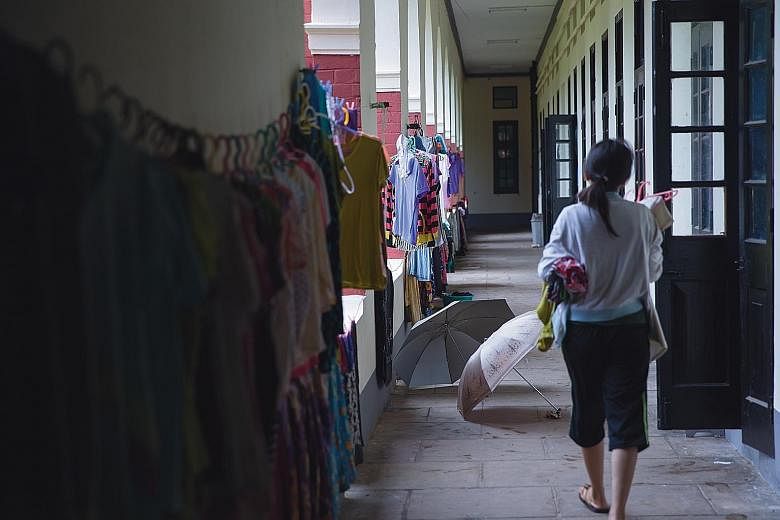Unruly, overgrown grass lines the fences. A stray dog is taking a nap on the main road that stretches across the length of the campus. Save for the rustling of leaves from trees along the pathway, all is quiet.
Only a handful of students are making their way to class. Most of them are dressed in longyi, a traditional sarong-like garment worn by men and women in Myanmar, with a sprinkling of foreign students in their midst.
It is a school day in July, and two years since the undergraduate programme reopened at Myanmar's oldest university after two decades of closure in a shutdown ordered by the military junta.
As the nation awaits a landmark general election next Sunday, the university is one to watch as it was in these compounds that calls for democracy first rang out back in 1988.
Then, discontent with the military junta resulted in the largest protests in Myanmar's history - led by students, many of them undergraduates. The military crackdown that followed left at least 3,000 people dead, including students from the University of Yangon.
"The whole authoritarian system destroyed education," said alumnus San Thar Aung, referring to Myanmar's decades-long military rule. "They always fear the students when they talk about education, thinking it's an opposition movement against the regime."
After the protests, the undergraduate programme at the university was shut down and only postgraduate students were accepted for advanced diploma, master's and doctorate courses.
Said prorector Kyaw Naing: "The military government changed the policy. They were afraid that the university was a centre of political movement, and the undergraduate students were scattered to universities around Yangon."
A NEW START
Since 2011, when the current government made up of mostly retired generals took over, the country has opened up and implemented a series of economic and political reforms. These included the restarting of the university's undergraduate programme in 2013, and the admission of a small number of foreign students as part of international exchange programmes.
Students, like geology undergraduate Suun Wunna Htet, 18, believe the University of Yangon is as good as it gets in Myanmar. "Compared with other universities in the country, I think we have good facilities, teachers and laboratory equipment," he said.
However, even as improvements are under way, the scars of the institution's politically controversial past have yet to heal. Student enrolment, for one thing, has yet to match up with the past.
During the 1990s, several departments, including medicine and technology that were earlier split from the university, further reduced student enrolment from an estimated 60,000 to about 6,000 students. What followed was the setting up of independent colleges for each of these departments spread throughout Yangon, which still exist today as the University of Medicine 1 and the Yangon Technological University.
Now, up to 50 undergraduate students are accepted into each of the 20 academic departments at the University of Yangon. With only 1,221 first- and second-year students enrolled in the university, the bulk of the 4,500 student population are postgraduate students.
And because of the large number of postgraduate students, Dr Kyaw Naing said there is "limited space" within the university for undergraduates. According to Professor San Shwe, limiting student enrolment also ensures that only the brightest are accepted into the undergraduate programme.
But the falling numbers have hurt student life which, today, is a pale shadow of what Dr Thaw Kaung, 77, remembers when he was an undergraduate studying English literature in 1954. "Student life back then was very good... We had many clubs. But these clubs all got broken up when the student numbers went down," said the retired librarian.
'GROUP PHOBIA'
While there is no way to know for sure, undergraduate Paing Thet Phyo believes he has started the first social reading club in the university in decades.
The club, which has nearly 50 members, was formed in August last year when he was in his first year. The aim was to revive a culture of clubs and societies that was once a big part of student life at the university. Today, what's left are a few groups that do sports and cultural activities.
"In the past, there were a lot of clubs. But after the university reopened, there was none. Students don't know what clubs are and what you do in a club. They don't even hear about it," said the 18-year-old at the Taung Ngu Hall canteen, accompanied by five club members.
Although the club is not registered officially under the university, at least 20 students attend the meetings each time to talk about their subjects and current affairs.
"As university students, we need to have a platform to discuss and debate," said the archaeology student.
However, in recruiting his members, Mr Paing Thet Phyo witnessed first-hand how some students are still fearful of provoking the authorities by gathering in groups.
"In their minds, they like the idea. But they are afraid to group like this," he said. "This is the tradition in Myanmar. People are conscious of student gatherings because they think it might become a protest."
His lecturer, Dr Pyiet Phyo Kyaw, coined a term for it. "Group phobia," said the assistant lecturer.
"Even in the University Teachers' Association, which is recognised officially, the teachers are afraid.
They are just afraid to participate or join the organisation," added Dr Pyiet Phyo Kyaw, who is the secretary of the association.
However, Mr Paing Thet Phyo feels there is no reason for him to be afraid. "We can discuss about education, the economy and even politics. But we won't organise protests or try to provoke the government."
He added that another key to reviving campus life is to reconstruct the student union building. Bombed by the military government in 1962, the building was the centre of student life before the closures.
"It was the greatest club of this university," he said. "There, students could become the changers of society and help develop the country. The destroying of the union building was like destroying the country."


